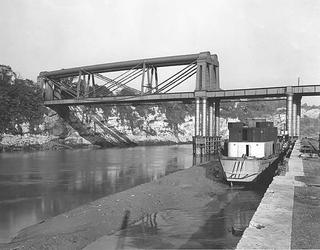
Boundary stone, Stockton & Darlington Railway
- Made:
- circa 1821-1825 in Durham
Stockton & Darlington Railway boundary stone dating from about 1821 to 1825. Dressed stone inscribed "S & D R" in Roman letters. The top right face of the stone is damaged, so most of the "&" is missing. The top face of the stone is painted white.
Boundary marker, Stockton & Darlington Railway, probably dating from about 1821 to 1825.
Boundary markers like this were used to clearly identify the limits of railway land and to distinguish them from adjacent property. They were typically used where it was difficult to install a fence or hedge, where there was a risk of encroachment by other landowners, or where there had been a dispute over land ownership.
The Stockton & Darlington Railway was authorised by an Act of Parliament passed in April 1821. It gave the company powers to compulsorily purchase land needed for the railway and stipulated that its boundaries had to be marked ‘with good and sufficient Posts, Rails, Hedges, Ditches, Mounds, or other Fences’.
This boundary marker is a piece of dressed stone with the company initials, “S & D R” inscribed in two lines of Roman lettering on its face. The top of the stone has been damaged, so most of the ampersand (&) is missing. The majority of the stone would have been buried to make it difficult for it to be dug up and removed. The top face of the stone has at some point been painted white and the letters were possibly once painted black, although most surviving Stockton & Darlington Railway boundary stones have no traces of paint.
The Stockton & Darlington Railway was built to connect Durham collieries with the towns of Stockton-on-Tees and Darlington and opened on 27 September 1825. It was the world’s first public railway to use steam locomotives and significantly influenced the development of railways in Britain. The company and its lines were taken over by the North Eastern Railway in 1863.
Details
- Category:
- Railway Infrastructure
- Object Number:
- 1985-7060
- Materials:
- Stone
- type:
- boundary stone
- credit:
- British Rail, Historical Relics




